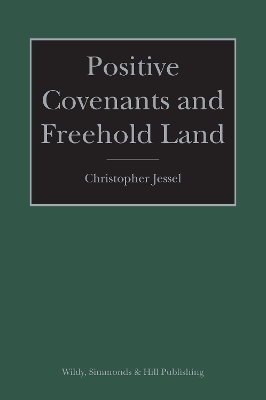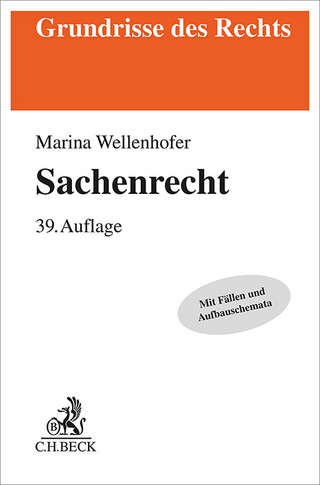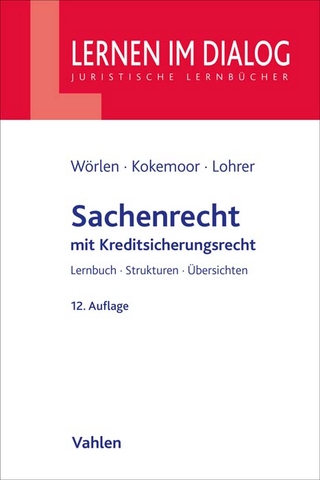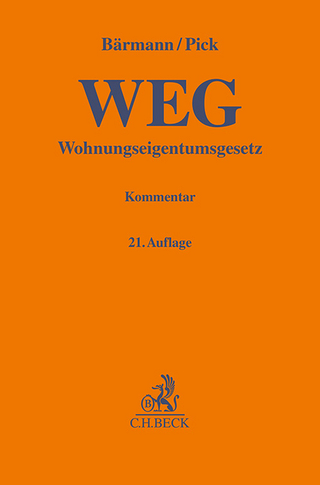
Positive Covenants and Freehold Land
Wildy, Simmonds and Hill Publishing (Verlag)
978-0-85490-269-9 (ISBN)
Positive covenants are obligations binding the owner of land for the time being which require some form of action or expenditure such as keeping a roof or wall in repair or paying instalments of service charge over many years.
Positive Covenants and Freehold Land concerns the rule of property law that a positive covenant cannot bind successors in title to the original covenantor. It considers the origin of the rule, the legal reasoning behind it, and the historical, social and political context in which it has developed. The book then looks at the various methods to circumvent it by using restrictions on the register of title, estate rentcharges, rights of re-entry, the principle of benefit and burden and the use of long leases as virtual freeholds.
A modern structure designed to overcome the problem is the system of commonhold which is currently under review by the Law Commission. The law of easements, particularly in relation to fencing, and the law of nuisance can have the effect of imposing positive obligations on landowners. Statutes can also either require owners to take specified steps such as keeping listed buildings in repair or they can authorise a landowner to enter into obligations as under the Town and Country Planning Act s 106. Separate chapters examine the issues to be considered on assignment of the benefit of positive covenants, on the transfer of land which is subject to the burden of them, and on the way that covenants operate in the management of housing and commercial estates.
Reform of the law of positive covenants has been in prospect for over 50 years without any response by Parliament but there is now the possibility of Government support. A chapter is included on issues to be borne in mind in drafting covenants and an examination of the juristic nature of positive covenants and their nature as part of a neighbour relationship. The book also features a number of suggested precedents for the practitioner.
Christopher Jessel is a solicitor and was a partner with Farrer & Co of Lincoln’s Inn Fields, practising in rural property, constitutional and charity law and was previously Assistant Editor of the Rights of Way Law Review. He has written articles and books on property-related subjects including A Legal History of the English Landscape, Farms and Estates: A Conveyancing Handbook (2nd ed) and Development Land Overage and Clawback (2nd ed).
Preface
Table of Cases
Table of Statutes
Table of Statutory Instruments
List of Abbreviations
1 THE PROBLEM
1.1 Preliminary
1.2 Reasons for the rule
1.3 Social context
1.4 Historical and political background
1.5 Conclusion
1.6 Arrangement of this book
2 FREEHOLD COVENANTS
2.1 Preliminary
2.2 Tulk v Moxhay
2.3 Later cases
2.4 Rhone v Stephens
2.5 Conclusion
3 RESTRICTIONS ON THE REGISTER
3.1 Preliminary
3.2 Expense and delay
3.3 Restrictions and restraints on alienation
3.4 Restrictions and trusts
3.5 Operation of the Land Registration Acts
3.6 Contractual restrictions
3.7 Law Commission review
3.8 Conclusion
4 ESTATE RENTCHARGES
4.1 Preliminary
4.2 Section 121
4.3 Law Commission report
4.4 Old cases
4.5 Rentcharges Act 1977 and cases
4.6 Legal charges
4.7 Conclusion
5 RIGHT OF RE-ENTRY
5.1 Preliminary
5.2 Shiloh Spinners v Harding
5.3 Re-entry to do works
5.4 Private statutory powers of entry
5.5 Conclusion
6 BENEFIT AND BURDEN
6.1 The pure principle
6.2 Thamesmead Town v Allotey
6.3 Later cases
6.4 Equitable interest and land registration
6.5 Permissive waste
6.6 Conclusion
7 EASEMENTS AND NUISANCE
7.1 Preliminary
7.2 Fencing: custom and easement
7.3 Fencing: statute
7.4 Support
7.5 Rights of way, water and electricity
7.6 Recreational easements
7.7 Neighbour relations
7.8 Conclusion
8 LONG LEASES
8.1 Preliminary
8.2 History and current use
8.3 Possession and ownership
8.4 Covenants and forfeiture
8.5 Management and service charges
8.6 Assignment
8.7 Incorporeal leases
8.8 Conclusion
9 ENLARGEMENT OF LONG TERMS
9.1 Preliminary
9.2 Preserved obligations
9.3 Touch and concern
9.4 Continuing tenurial relationship
9.5 Covenants affecting freehold land
9.6 Conclusion
10 COMMONHOLD
10.1 The commonhold system
10.2 Maintenance and insurance
10.3 Service charge and other disputes
10.4 Commonhold tenure
10.5 Conclusion
11 TENURE AND CUSTOMARY RIGHTS
11.1 Preliminary
11.2 Positive obligations by tenure
11.3 Customary obligations
11.4 Effect of feoffment
11.5 Highways and bridges
11.6 Chancel repairs
11.7 Embankment and sea and river walls
11.8 Overriding interests
11.9 Conclusion
12 STATUTORY OBLIGATIONS
12.1 Preliminary
12.2 Local authority obligations
12.3 Statutory duties
12.4 Environmental liability
12.5 Highways
12.6 Statutory powers of entry
12.7 Leasehold Reform Act schemes
12.8 Private or local Acts
12.9 Statutory torts
12.10 Conclusion
13 ASSIGNMENT OF BENEFIT
13.1 Preliminary
13.2 Common law and equity
13.3 Section 56
13.4 Section 78
13.5 Section 136
13.6 Contracts (Rights of Third Parties) Act 1999
13.7 Assignment of service charge and services
13.8 Conclusion
14 TRANSFER OF BURDEN
14.1 Preliminary
14.2 Voluntary transfer of whole
14.3 Transfer of whole by operation of law
14.4Transfer of part of servient land
15 ESTATE MANAGEMENT
15.1 Involving a manager
15.2 Trustees
15.3 Companies
15.4 Insolvency or dissolution of manager
15.5 Reconstruction of manager
16 ENFORCEMENT
16.1 Preliminary
16.2 Cases on mandatory injunctions
16.3 Landlord and tenant
16.4 Co-op v Argyll
16.5 Application to freeholds
16.6 The Shelfer Rules
16.7 Damages
16.8 Conclusion
17 DRAFTING
17.1 Preliminary
17.2 Neighbour covenants
17.3 Estate covenant schemes
17.4 Restriction on the register
17.5 Estate rentcharge
17.6 Right of re-entry
17.7 Virtual freholds
17.8 Leasehold easements
17.9 Indemnity clauses
17.10 Assignment of benefit
17.11 Variation of the scheme
17.12 Replacement of developer by manager
18 REFORM
19 TOWARDS A SOLUTION
19.1 The rule and its reason
19.2 Is the rule absolute?
19.3 Enforceable covenants
19.4 Relationship without contract
19.5 Remedies
19.6 Conclusion
PRECEDENTS
Preliminary
P1 Neighbour covenant by servient owner
P2 Estate covenants
P2.1 Developer’s covenant to do works, pay service charge, etc
P2.2 Manager’s covenants
P2.3 Developer’s covenant to pay service charge to manager
P2.4 Developer’s covenant to pay service charge to manager and transfer common parts following last sale
P2.5 Positive covenant by original buyer of unit to observe regulations
P2.6 Restrictive covenant to support deed of covenant
P2.7 Positive covenant to support deed of covenant
P2.8 Restriction
P2.9 Deed of covenant by first buyer of unit with manager
P2.10 Deed of covenant with restriction on register
P2.11 Short form deed of covenant by new owner
P2.12 Consent to dealing by Manager with benefit of restriction on the register
P3 Forms of restriction
P3.1 Form L – certificate of conveyancer
P3.2 Form L – certificate of manager
P3.3 Form M – Certificate of proprietor of benefited land
P3.4 Form N – consent of manager
P3.5 Form O – Consent or certificate
P3.6 Form NN – consent or certificate
P4 Estate rentcharges
P4.1 Definitions of rentcharge
P4.2 Estate rentcharge on sale of land with forfeiture on re-entry
P4.3 Estate rentcharge of nominal amount supporting covenant to pay service charge
P4.4 Clause in transfer reserving estate rentcharge with express right of re-entry
P4.5 Estate Rentcharge with protection for mortgagee
P5 Right of re-entry
P5.1 On forfeiture or to do works and recover cost
P6 Conditional grant
P6.1 Short form
P6.2 Fuller form
P7 Leasehold easements
P7.1 Grant of easement appurtenant to freehold unit
P7.2 Deed on change of proprietor of dominant land having a leasehold right
Index
| Erscheinungsdatum | 11.06.2019 |
|---|---|
| Verlagsort | London |
| Sprache | englisch |
| Maße | 152 x 229 mm |
| Gewicht | 588 g |
| Themenwelt | Recht / Steuern ► EU / Internationales Recht |
| Recht / Steuern ► Privatrecht / Bürgerliches Recht ► Sachenrecht | |
| ISBN-10 | 0-85490-269-4 / 0854902694 |
| ISBN-13 | 978-0-85490-269-9 / 9780854902699 |
| Zustand | Neuware |
| Haben Sie eine Frage zum Produkt? |
aus dem Bereich


